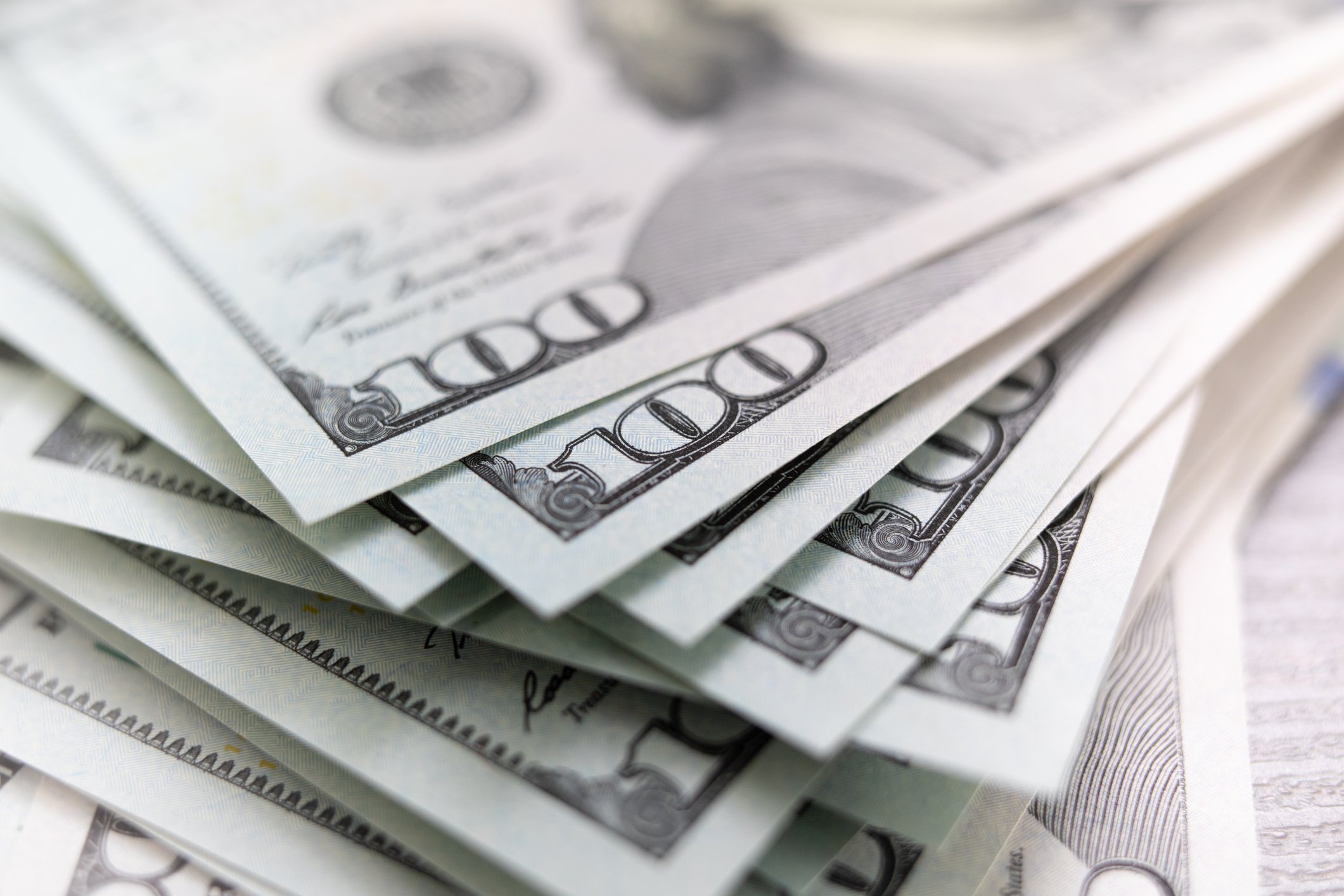Over the past two months, the stock market and U.S. economy have been rocked by the coronavirus disease 2019 (COVID-19). This unprecedented pandemic has wiped out more than 30 million jobs in a span of five weeks, and at one point had pushed the broad-based S&P 500 lower by as much as 34%.
In response to these economic disruptions, Congress passed and President Trump signed the largest stimulus package in history on March 27. The Coronavirus Aid, Relief, and Economic Security (CARES) Act totaled $2.2 trillion and set aside cash for distressed industries, small-business loans, hospitals, and the expansion of the unemployment benefits program.

Image source: Getty Images.
Up to 175 million Americans are expected to receive a stimulus check
But ask most Americans what interests them the most about the CARES Act, and they'll probably tell you it's the $300 billion directed toward stimulus payments to the American public. Officially known as Economic Impact Payments, these stimulus payouts can max out at $1,200 per individual taxpayer or $2,400 for a couple filing jointly. Additionally, qualifying dependent children aged 16 and under can add $500 to a parent's or household's stimulus check.
Admittedly, not everyone is going to receive stimulus money. High-income earners (defined as single, married, and head-of-household tax filers with adjusted gross income [AGI] above $99,000, $198,000, and $136,500, respectively), dependents aged 17 and older, and non-citizens with no legal pathway to citizenship aren't going to receive a dime.
Still, that's 175 million Americans that are going to get stimulus money. Many of them will wind up receiving the maximum amount, which is given to single, married, and head-of-household filers with respective AGIs below $75,000, $150,000, and $112,500 in their most recent tax filing.
What will America do with its stimulus money, you ask? While most surveys have shown that Economic Impact Payments will go toward paying bills or buying essentials, such as groceries, close to 1 in 10 respondents of most surveys suggest that they plan to invest their stimulus money into the stock market. Assuming you can afford to do so, it's a really smart idea. After all, the stock market tends to double the typical investor's money about once a decade, and every bear market in history has proved to be a buying opportunity.
If you plan to put your $1,200 in stimulus money to work on Wall Street, here are the three safest stocks you can consider buying.

Image source: Getty Images.
Microsoft
The first stock stimulus check recipients can consider buying with confidence is software kingpin Microsoft (MSFT 0.44%). Something you may not know about Old Softy is that it's one of only two publicly traded companies that still bears the coveted AAA credit rating from Standard & Poor's (S&P). Microsoft ended its most recent quarter (March 31, 2020) with $137.6 billion in cash, cash equivalents, and marketable securities, compared to $62.9 billion in long-term debt and $3.7 billion in long-term debt due within 12 months.
What investors get when they buy Microsoft is a synergy between high-margin legacy businesses and a push toward next-generation cloud services and enterprise software.
For instance, cloud services segment Azure delivered 61% constant currency year-on-year sales growth in the latest quarter, even with COVID-19 disrupting supply chains globally. Office 365 Commercial and Windows Commercial and cloud products segments also delivered respective constant currency sales growth of 27% and 18% from the previous year, demonstrating growing tie-ins with enterprise customers.
Meanwhile, some investors might chide Microsoft for its flat Windows operating system (OS) growth. But keep in mind that Windows remains the dominant OS for personal computers, meaning margins for this legacy segment remain particularly high.
Not only can Microsoft deliver double-digit growth as a trillion-dollar company, but it's quietly become a star dividend stock. Over the past 15 years, its quarterly payout has grown from $0.08 per share to $0.51 per share. It's about as safe a stock as they come in the technology sector.

Image source: Getty Images.
American Water Works
Another way you can turn $1,200 in stimulus money into a lot more money over the long run without significant risk is to buy water and wastewater services provider American Water Works (AWK +1.81%).
The first thing you should note about this stock is that it's supplying a basic-need good or service. If you own or rent a home, you need access to running water. That means water consumption and wastewater servicing tends to be exceptionally predictable regardless of how well or poorly the economy is performing. It's this predictability of cash flow that allows American Water Works to plot out its investments so far in advance.
Yet another key selling point of this water utility is that it operates over 52,000 miles of pipes, and services approximately 15 million people across 46 U.S. states. Operating in so many states and jurisdictions provides geographic diversity to its revenue stream (thus de-risking it even more). It also doesn't hurt that water utilities typically operate as monopolies or oligopolies within a county or state.
Furthermore, 88% of its operations are regulated by state-level utility commissions. Though this does stop American Water Works from passing along price hikes at will, it also means that the vast majority of the company's operations aren't exposed to potentially volatile wholesale pricing.
With American Water Works expected to put $20 billion to $22 billion to work over the next decade in upgrading its infrastructure, and the company more than willing to make small but steady acquisitions, a 7% to 10% compound annual growth rate is fully expected through 2024. Tack on a healthy 10% dividend hike last week to $0.55 per quarter and you have the makings of an extremely safe investment.

Image source: Getty Images.
Johnson & Johnson
People expecting the maximum amount of stimulus money can also put that money to work in what I consider to be the safest healthcare stock of all, Johnson & Johnson (JNJ +2.61%). In case you were wondering, Johnson & Johnson is the other public company that the S&P bestows with the AAA credit rating. In other words, S&P has more confidence in J&J to repay its outstanding debts than it does of the U.S. government making good on its own debts.
One factor that makes Johnson & Johnson such a perfect defensive play in any economic environment is the fact that we don't get to choose when we get sick or what ailment(s) we develop. Illnesses don't care if there's an economic contraction. This means J&J can expect a consistent stream of cash flow given that folks who needed pharmaceuticals last month are liable to need them in the months that lie ahead, too.
Johnson & Johnson's three operating segments also fit together like a perfect puzzle. Consumer health products is the slowest growing, but it provides the most predictable cash flow and excellent pricing power. Meanwhile, medical-device growth has been somewhat constrained recently, but is set up perfectly over the long run to take advantage of an aging population. Finally, pharmaceuticals provide J&J with the bulk of its growth and margins, but brand-name therapies have a finite period of exclusivity.
And who can forget that Johnson & Johnson has raised its dividend for 58 consecutive years. Shareholders of J&J are currently netting a cool 2.7% yield.
Riding a streak of 36 straight years of adjusted operating earnings growth, J&J is a no-brainer stock for risk-averse investors to buy.








